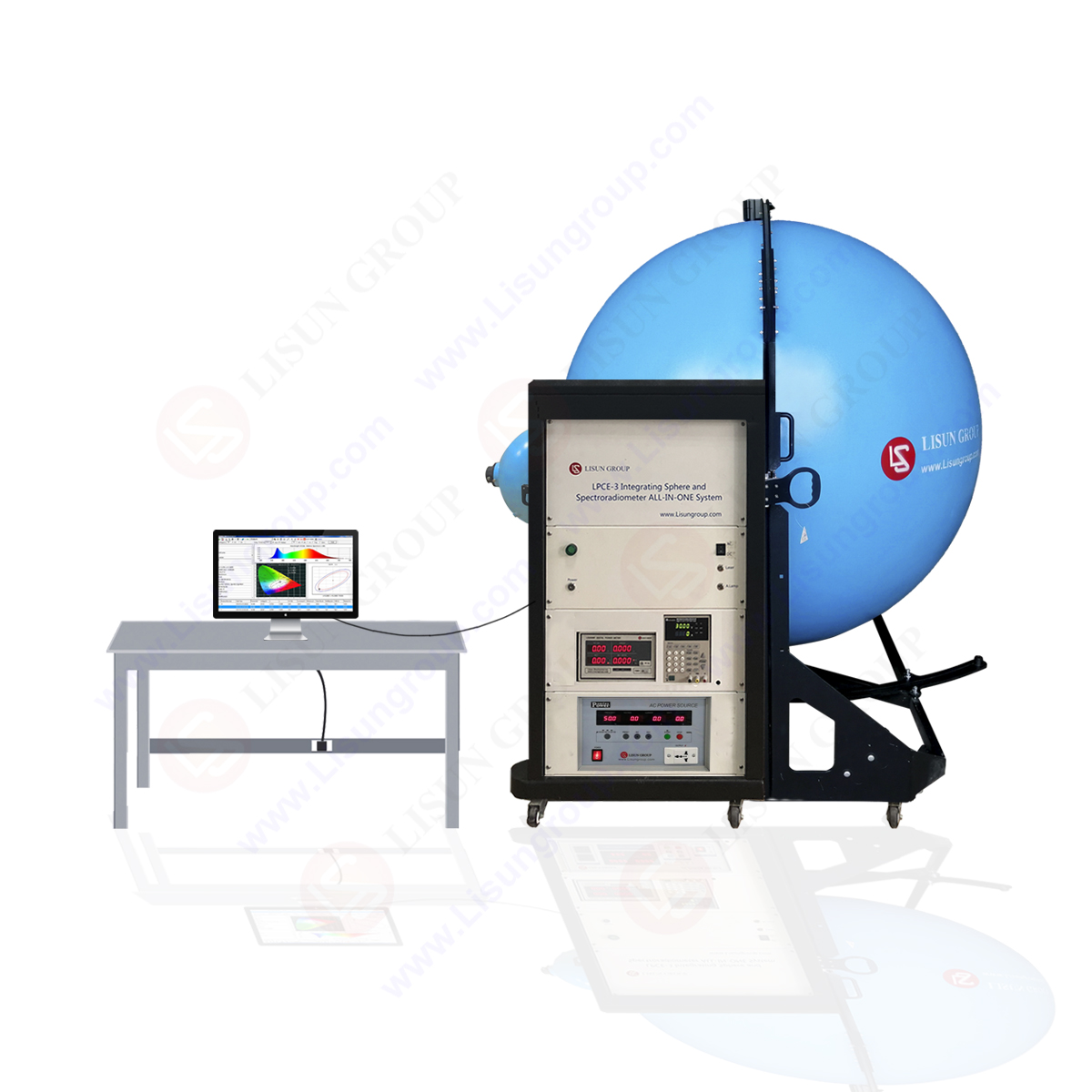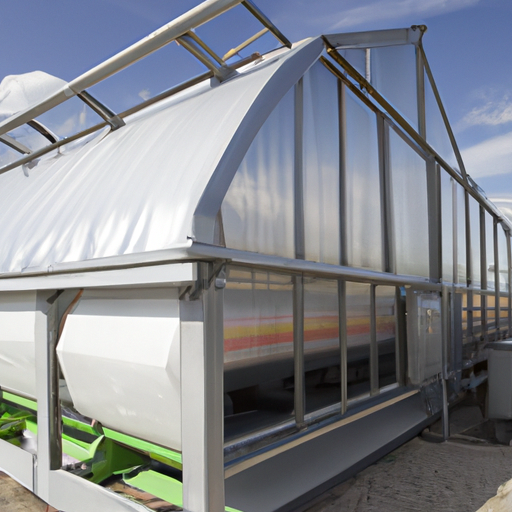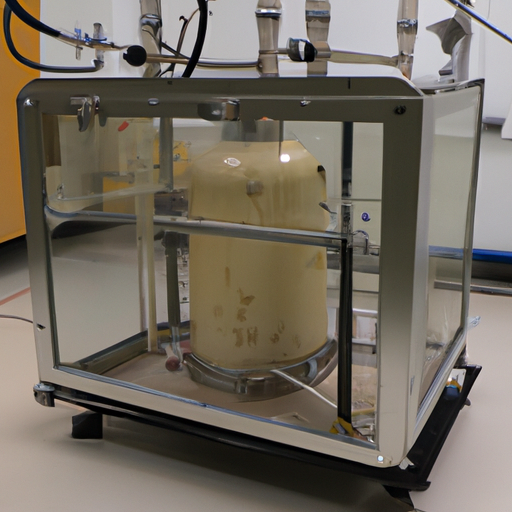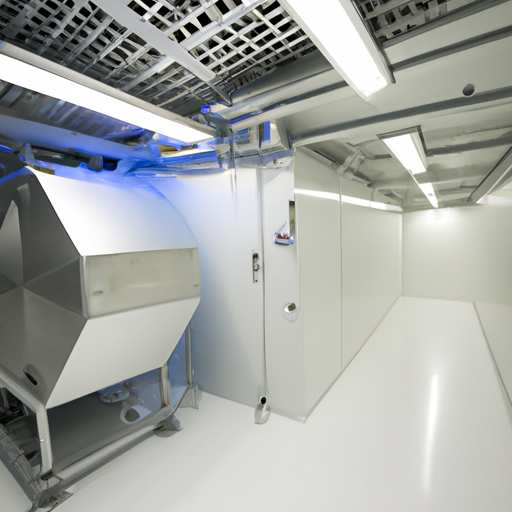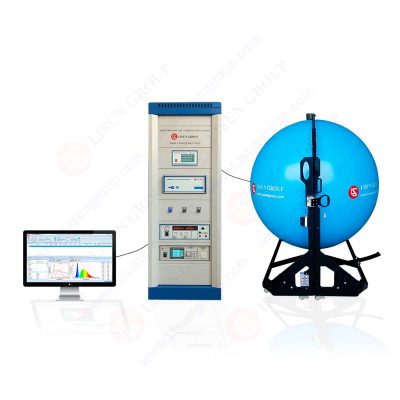LPCE-2 Integrating Sphere Spectroradiometer LED Testing System is for single LEDs and LED lighting products light measurement. LED’s quality should be tested by checking its photometric, colorimetric and electrical parameters. According to CIE 177, CIE84, CIE-13.3, IES LM-79-19, Optical-Engineering-49-3-033602, COMMISSION DELEGATED REGULATION (EU) 2019/2015, IESNA LM-63-2 and ANSI-C78.377, it recommends to using an array spectroradiometer with an integrating sphere to test SSL products. The LPCE-2 system is applied with LMS-9000C High Precision CCD Spectroradiometer or LMS-9500C Scientific Grade CCD Spectroradiometer, and A molding integrating sphere with holder base. This sphere is more round and the test result is more accruacy than the traditional integrating sphere.
The integrating sphere test system is used to test various of LEDs/LED lamps and luminaires/fxiture for measure the light color parameters such as spectrum, color and luminous flux
The measure parameters of the integrating sphere & spectroradiometer test system are as follows:
The main parameters:
Chromaticity coordinates(x/y, u/v), Color Temperature(CCT), Color Ratio, Peak Wavelength, Half Bandwidth, Dominant Wavelength, Color Purity, CRI, CQS, TM-30-18 (Rf, Rg), Spectrum Test, Luminous Flux, Luminous Efficiency, Radiant Power, EEI, Energy Efficiency Class, Pupil Flux, Pupil Flux Efficiency, Pupil Factor and Cirtopic Flux, etc.
Electrical parameters:
Voltage, Current, Power, Power Factor, Displacement Factor, Harmonic(THD)
1. Spectral & Photometric method
The Spectral & Photometric method was used to test light source for measure luminous flux photometric method and measure color parameters by spectral method
The Photometric method to do luminous flux measurement which means use standard light source(standard lamp) with known absolute luminous flux (the value traceable to NIM) in the integrating sphere to compare it with the measured light source to obtain a coefficient, so as to obtain the luminous flux of the measured light source. The basic principle of luminous flux measurement is to place the light source to be measured in the integrating sphere, and coat the inner wall of the integrating sphere with a white diffuse reflection layer (spectral reflectance ρ≥0.98). The illuminance on the wall is uniformly distributed, and the luminous flux projected on the photo-detector through the hole on the spherical wall should be proportional to the total luminous flux emitted by the light source. In order to make the relative spectral sensitivity of the photo-detector on the spherical wall conform to the spectral optical efficiency of the human eye, the method of adding a filter set is generally used for correction. By calculating the propagation and conditions of light in the filter glass group, according to the typical transmittance characteristic curve of the known colored glass types, select the colored glass group with the appropriate matching curve, and then calculate the required matching curve according to the formula. Appropriate thickness, and finally corrected to obtain the luminosity value.
2. Spectral method:
The full spectral method requires that the absolute spectral power distribution corresponding to every 5nm wavelength in the visible light band from 380~780nm must be known, and the absolute spectral power corresponding to each wavelength should be calibrated by the NIM within a specified time. After the corresponding absolute spectral power distribution of each wavelength is known, the absolute spectral power distribution list is made into the absolute spectral power distribution data of standard lamps that can be read by the software, and the photoelectric detection on the spherical wall window can be removed. The measuring instrument is directly connected to the inner window of the sphere wall by the optical fiber, and the other end of the optical fiber is connected to the incident slit of the spectrum analyzer. The light is introduced into the grating monochromator, and the ratio of the optical power corresponding to each wavelength of the standard lamp can be measured. After amplification by PMT, the photocurrent ratio can be obtained, and then the absolute spectral power distribution P of the standard lamp can be calculated relative to the The absolute spectral power distribution of the lamp. According to the conversion formula of radiation quantity and photometric quantity, for the luminous flux of the standard lamp and the lamp to be tested, the relative spectral power distribution is calculated from the absolute spectral power distribution, and then the color coordinates and chromaticity are obtained by the same method as the spectral photometry method. Tolerance, correlated color temperature, color rendering index and other photoelectric parameters.

Lisun Instruments Limited was found by LISUN GROUP in 2003. LISUN quality system has been strictly certified by ISO9001:2015. As a CIE Membership, LISUN products are designed based on CIE, IEC and other international or national standards. All products passed CE certificate and authenticated by the third party lab.
Our main products are Goniophotometer, Integrating Sphere, Spectroradiometer, Surge Generator, ESD Simulator Guns, EMI Receiver, EMC Test Equipment, Electrical Safety Tester, Environmental Chamber, Temperature Chamber, Climate Chamber, Thermal Chamber, Salt Spray Test, Dust Test Chamber, Waterproof Test, RoHS Test (EDXRF), Glow Wire Test and Needle Flame Test.
Please feel free to contact us if you need any support.
Tech Dep: Service@Lisungroup.com, Cell/WhatsApp:+8615317907381
Sales Dep: Sales@Lisungroup.com, Cell/WhatsApp:+8618117273997

 中文简体
中文简体
